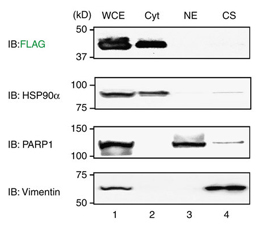Research Abstract
ヒトのエンドヌクレアーゼVはイノシンを含むRNAに特異的に働くリボヌクレアーゼである
Human endonuclease V is a ribonuclease specific for inosine-containing RNA
2013年8月5日 Nature Communications 4 : 2273 doi: 10.1038/ncomms3273

DNA塩基が脱アミノ化されると、がんの原因となるミスセンス変異が生じることがあり、また他の基本的な分子遺伝学的過程が妨げられることもある。この脱アミノ化によって、デオキシアデノシンからデオキシイノシンは生じる。大腸菌(Escherichia coli)では、高度に保存されているエンドヌクレアーゼVが、デオキシイノシンをDNAから取り除くAER(alternative excision repair)という除去修復機構に関わっている。しかし、この酵素のヒトでの働きと役割についてはまだ分かっていない。我々は今回、大腸菌エンドヌクレアーゼVのヒト・ホモログであるタンパク質FLJ35220、すなわちhEndoVがイノシンを含むRNAに特異的に働くリボヌクレアーゼであることを明らかにした。hEndoVはRNAに選択的に結合して、dsRNA中の、イノシンが存在して塩基対を作っていないssRNA領域で、イノシンの3′側に位置する2番目のホスホジエステル結合を効率よく加水分解する。さらにhEndoVは細胞質に局在し、そのリボヌクレアーゼ活性はTudorスタフィロコッカスヌクレアーゼによって促進されること、またRNAに作用するアデノシンデアミナーゼの働きによって生じたイノシンを含むdsRNAに活性があることが明らかになった。これらの結果は、hEndoVがヒトでイノシンを含むRNAの運命を制御していることを示している。
森田 陽子1, 渋谷 敏博1, 中西 望1, 西倉 和子2, 岩井 成憲1 & 倉岡 功1
- 大阪大学大学院 基礎工学研究科
- ウィスター研究所(米国)
Deamination of DNA bases can create missense mutations predisposing humans to cancer and also interfere with other basic molecular genetic processes; this deamination generates deoxyinosine from deoxyadenosine. In Escherichia coli, the highly conserved endonuclease V is involved in alternative excision repair that removes deoxyinosine from DNA. However, its exact activities and roles in humans are unknown. Here we characterize the FLJ35220 protein, the human homologue of E. coli endonuclease V, hEndoV as a ribonuclease specific for inosine-containing RNA. hEndoV preferentially binds to RNA and efficiently hydrolyses the second phosphodiester bond located 3′ to the inosine in unpaired inosine-containing ssRNA regions in dsRNA. It localizes to the cytoplasm in cells. The ribonuclease activity is promoted by Tudor staphylococcal nuclease and detected on inosine-containing dsRNA created by the action of adenosine deaminases acting on RNA. These results demonstrate that hEndoV controls the fate of inosine-containing RNA in humans.

